University Financial Reporting: CPI Limited Case Study Analysis
VerifiedAdded on 2023/03/20
|12
|1913
|35
Report
AI Summary
This report provides a comprehensive analysis of financial reporting, focusing on key aspects such as IAS 16 and investment property. The report begins with an examination of a case study involving CPI Limited, addressing the accounting treatment of rehabilitation expenses for a gold mine. It delves into the intricacies of recognizing these expenses, including present value calculations and the inadequacy of the director's proposed provision. The report then explores the capitalization of various costs, including feasibility studies, architect fees, site clearance expenses, and materials used in construction. The report also defines investment property under IAS 40, outlining its characteristics and the different methods of measurement, including the fair value model and the revaluation model. The report emphasizes the importance of understanding these models for accurate financial reporting and valuation. Finally, the report incorporates references to relevant academic literature and standards to support its analysis.
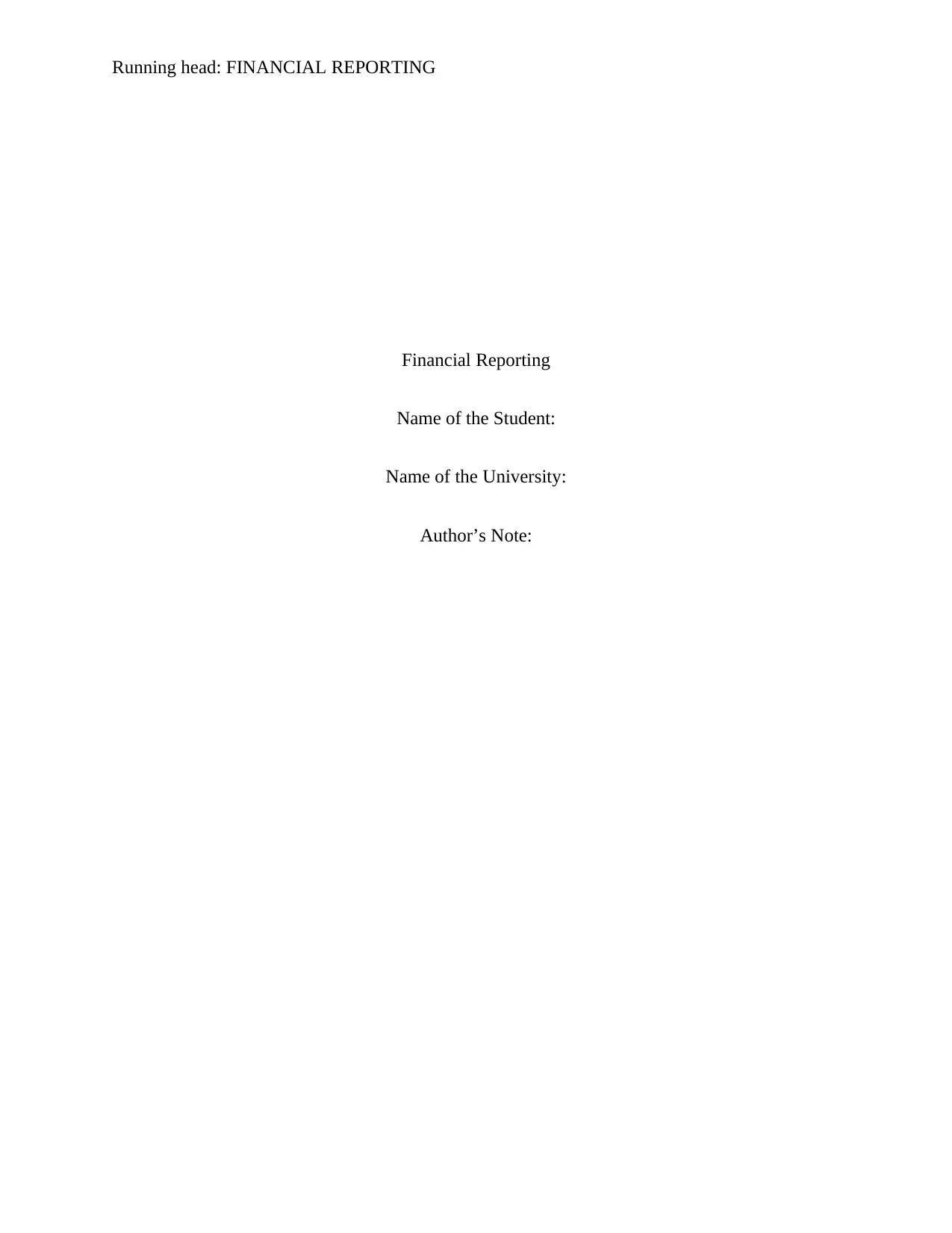
Running head: FINANCIAL REPORTING
Financial Reporting
Name of the Student:
Name of the University:
Author’s Note:
Financial Reporting
Name of the Student:
Name of the University:
Author’s Note:
Paraphrase This Document
Need a fresh take? Get an instant paraphrase of this document with our AI Paraphraser
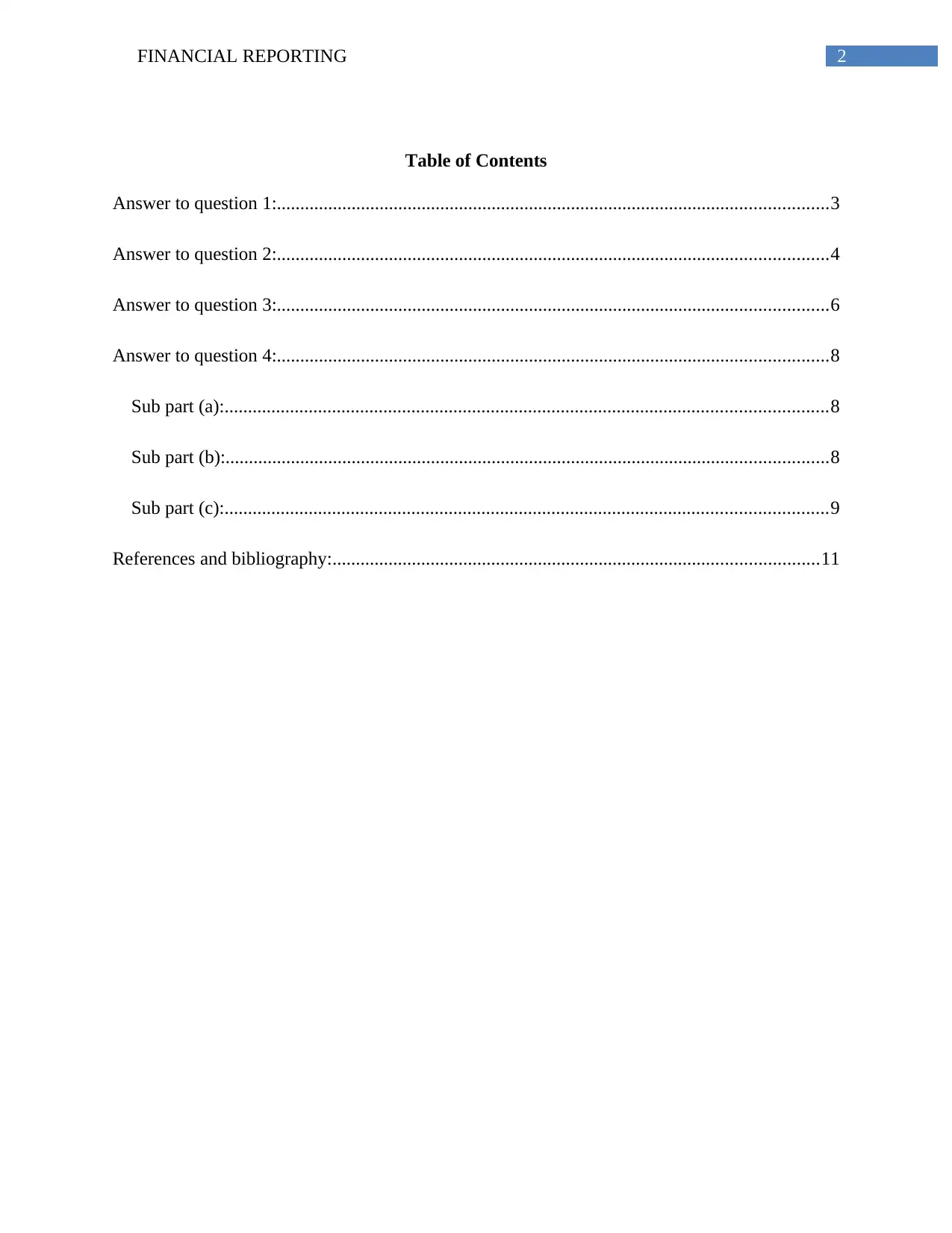
2FINANCIAL REPORTING
Table of Contents
Answer to question 1:......................................................................................................................3
Answer to question 2:......................................................................................................................4
Answer to question 3:......................................................................................................................6
Answer to question 4:......................................................................................................................8
Sub part (a):.................................................................................................................................8
Sub part (b):.................................................................................................................................8
Sub part (c):.................................................................................................................................9
References and bibliography:........................................................................................................11
Table of Contents
Answer to question 1:......................................................................................................................3
Answer to question 2:......................................................................................................................4
Answer to question 3:......................................................................................................................6
Answer to question 4:......................................................................................................................8
Sub part (a):.................................................................................................................................8
Sub part (b):.................................................................................................................................8
Sub part (c):.................................................................................................................................9
References and bibliography:........................................................................................................11
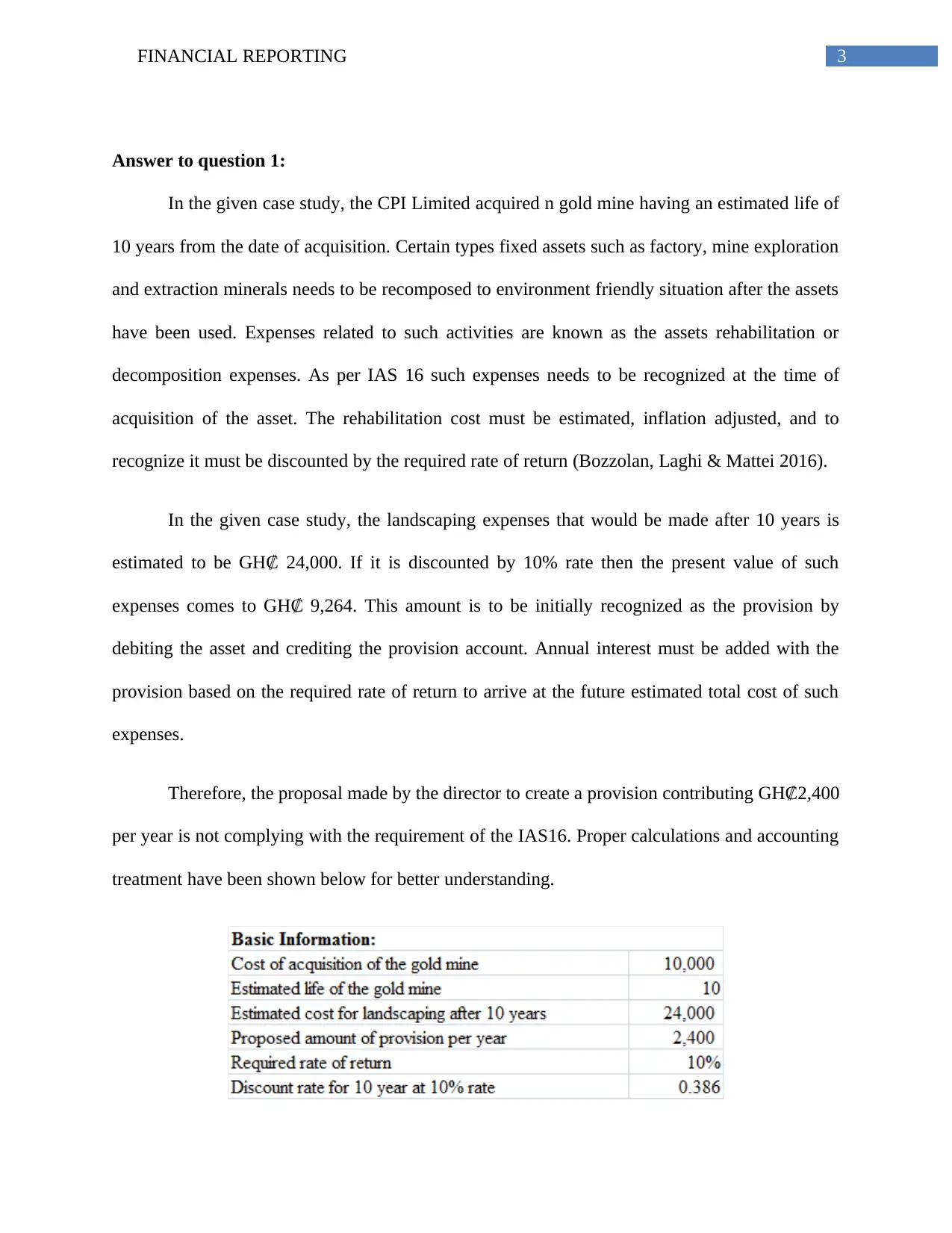
3FINANCIAL REPORTING
Answer to question 1:
In the given case study, the CPI Limited acquired n gold mine having an estimated life of
10 years from the date of acquisition. Certain types fixed assets such as factory, mine exploration
and extraction minerals needs to be recomposed to environment friendly situation after the assets
have been used. Expenses related to such activities are known as the assets rehabilitation or
decomposition expenses. As per IAS 16 such expenses needs to be recognized at the time of
acquisition of the asset. The rehabilitation cost must be estimated, inflation adjusted, and to
recognize it must be discounted by the required rate of return (Bozzolan, Laghi & Mattei 2016).
In the given case study, the landscaping expenses that would be made after 10 years is
estimated to be GH₡ 24,000. If it is discounted by 10% rate then the present value of such
expenses comes to GH₡ 9,264. This amount is to be initially recognized as the provision by
debiting the asset and crediting the provision account. Annual interest must be added with the
provision based on the required rate of return to arrive at the future estimated total cost of such
expenses.
Therefore, the proposal made by the director to create a provision contributing GH₡2,400
per year is not complying with the requirement of the IAS16. Proper calculations and accounting
treatment have been shown below for better understanding.
Answer to question 1:
In the given case study, the CPI Limited acquired n gold mine having an estimated life of
10 years from the date of acquisition. Certain types fixed assets such as factory, mine exploration
and extraction minerals needs to be recomposed to environment friendly situation after the assets
have been used. Expenses related to such activities are known as the assets rehabilitation or
decomposition expenses. As per IAS 16 such expenses needs to be recognized at the time of
acquisition of the asset. The rehabilitation cost must be estimated, inflation adjusted, and to
recognize it must be discounted by the required rate of return (Bozzolan, Laghi & Mattei 2016).
In the given case study, the landscaping expenses that would be made after 10 years is
estimated to be GH₡ 24,000. If it is discounted by 10% rate then the present value of such
expenses comes to GH₡ 9,264. This amount is to be initially recognized as the provision by
debiting the asset and crediting the provision account. Annual interest must be added with the
provision based on the required rate of return to arrive at the future estimated total cost of such
expenses.
Therefore, the proposal made by the director to create a provision contributing GH₡2,400
per year is not complying with the requirement of the IAS16. Proper calculations and accounting
treatment have been shown below for better understanding.
⊘ This is a preview!⊘
Do you want full access?
Subscribe today to unlock all pages.

Trusted by 1+ million students worldwide
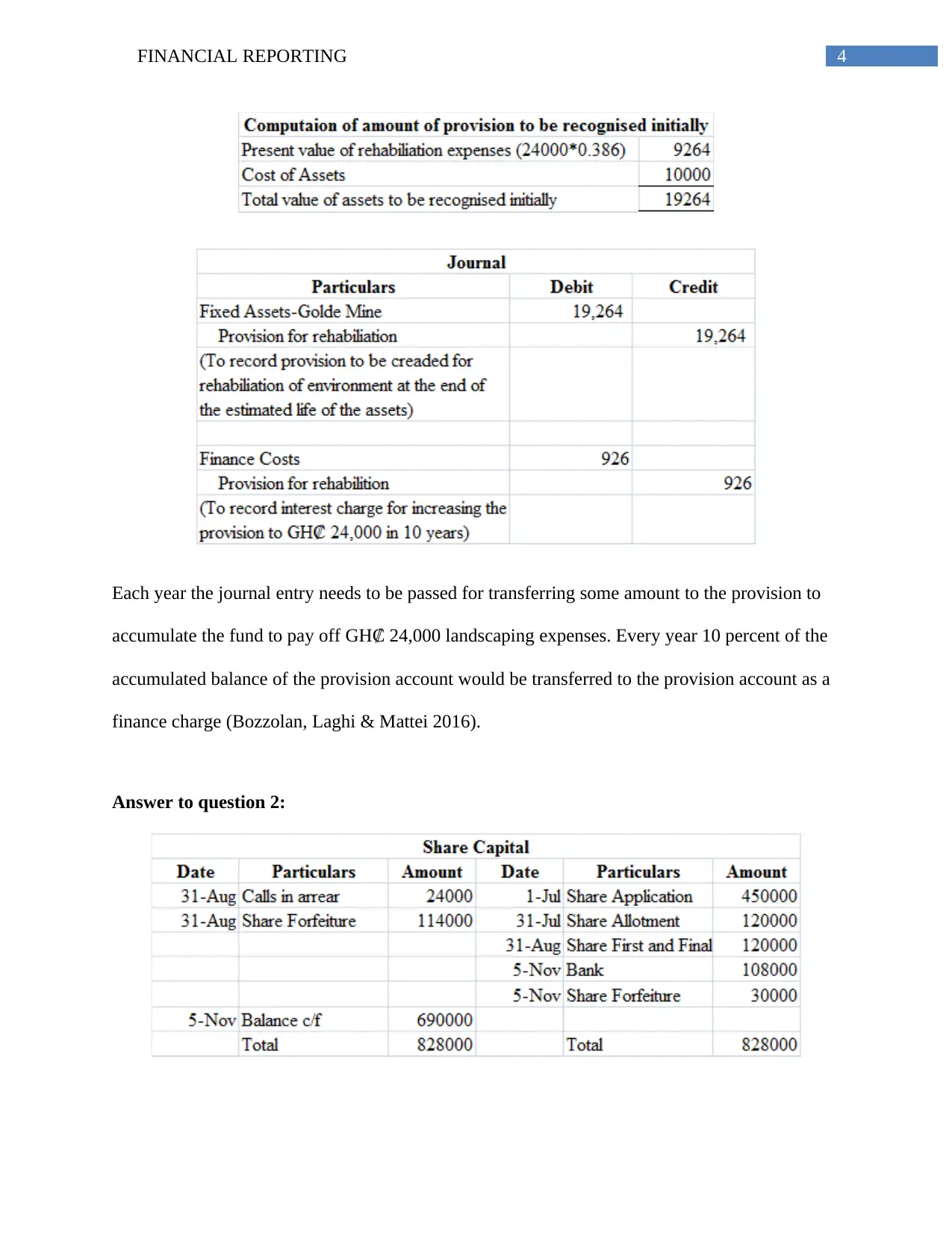
4FINANCIAL REPORTING
Each year the journal entry needs to be passed for transferring some amount to the provision to
accumulate the fund to pay off GH₡ 24,000 landscaping expenses. Every year 10 percent of the
accumulated balance of the provision account would be transferred to the provision account as a
finance charge (Bozzolan, Laghi & Mattei 2016).
Answer to question 2:
Each year the journal entry needs to be passed for transferring some amount to the provision to
accumulate the fund to pay off GH₡ 24,000 landscaping expenses. Every year 10 percent of the
accumulated balance of the provision account would be transferred to the provision account as a
finance charge (Bozzolan, Laghi & Mattei 2016).
Answer to question 2:
Paraphrase This Document
Need a fresh take? Get an instant paraphrase of this document with our AI Paraphraser
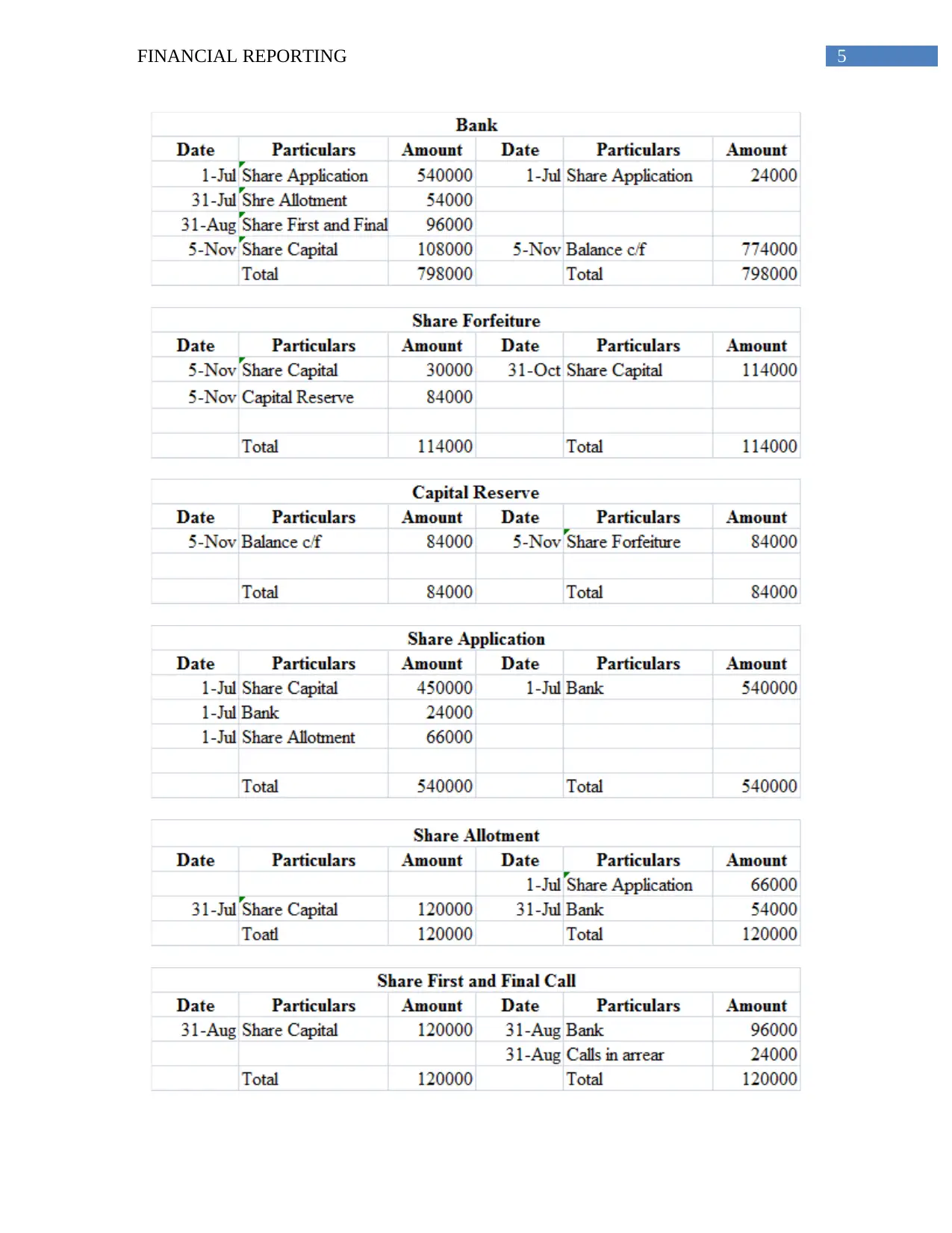
5FINANCIAL REPORTING
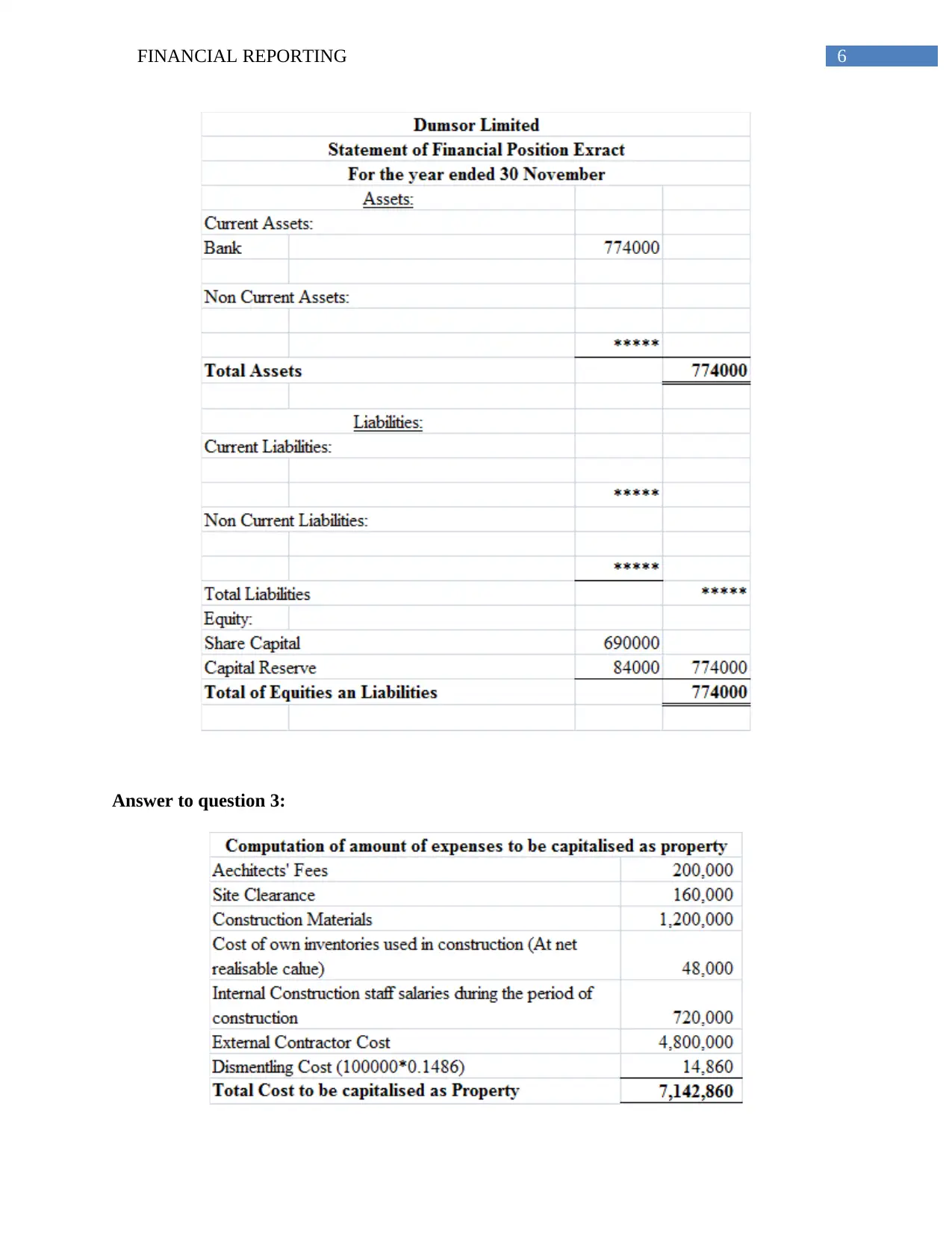
6FINANCIAL REPORTING
Answer to question 3:
Answer to question 3:
⊘ This is a preview!⊘
Do you want full access?
Subscribe today to unlock all pages.

Trusted by 1+ million students worldwide
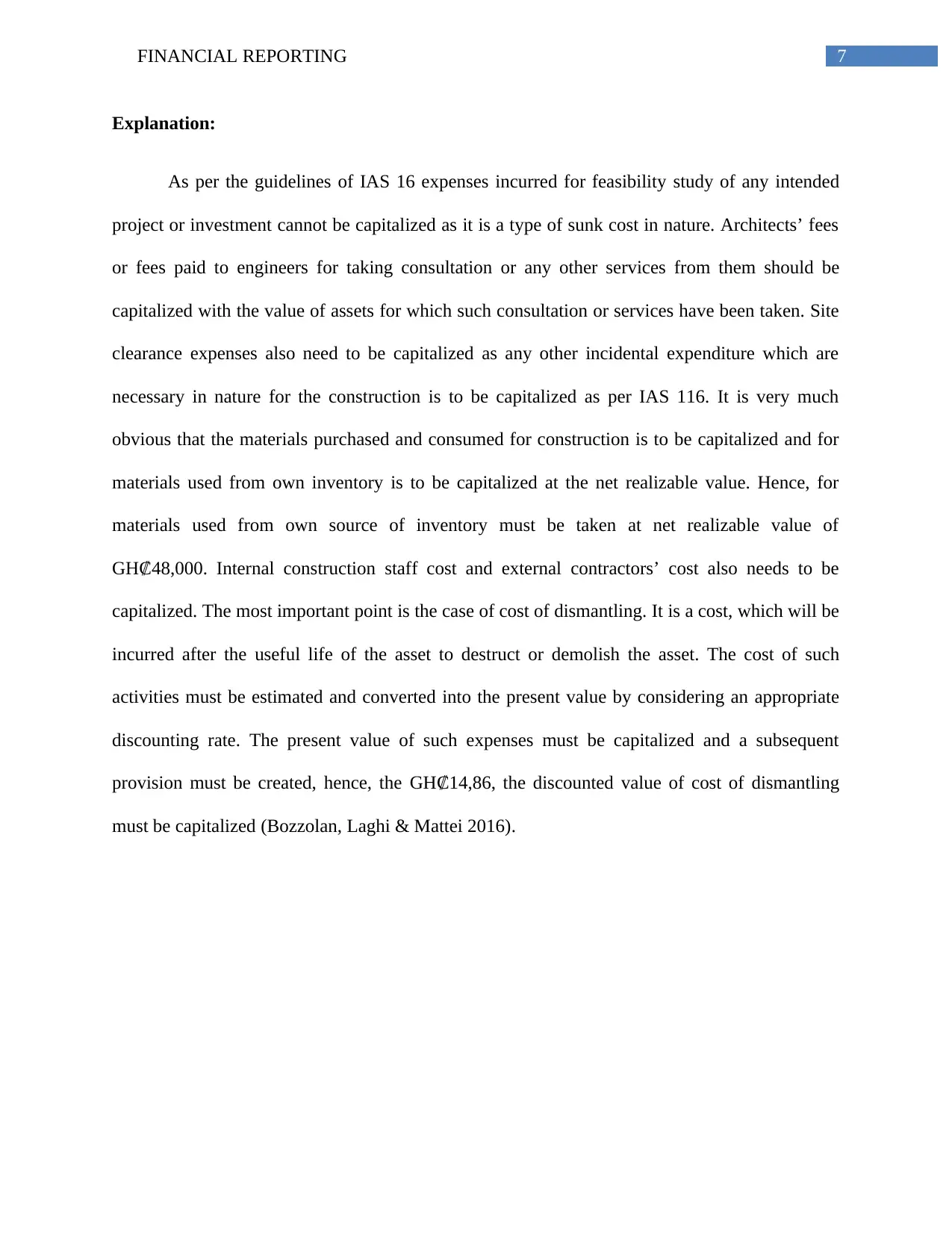
7FINANCIAL REPORTING
Explanation:
As per the guidelines of IAS 16 expenses incurred for feasibility study of any intended
project or investment cannot be capitalized as it is a type of sunk cost in nature. Architects’ fees
or fees paid to engineers for taking consultation or any other services from them should be
capitalized with the value of assets for which such consultation or services have been taken. Site
clearance expenses also need to be capitalized as any other incidental expenditure which are
necessary in nature for the construction is to be capitalized as per IAS 116. It is very much
obvious that the materials purchased and consumed for construction is to be capitalized and for
materials used from own inventory is to be capitalized at the net realizable value. Hence, for
materials used from own source of inventory must be taken at net realizable value of
GH₡48,000. Internal construction staff cost and external contractors’ cost also needs to be
capitalized. The most important point is the case of cost of dismantling. It is a cost, which will be
incurred after the useful life of the asset to destruct or demolish the asset. The cost of such
activities must be estimated and converted into the present value by considering an appropriate
discounting rate. The present value of such expenses must be capitalized and a subsequent
provision must be created, hence, the GH₡14,86, the discounted value of cost of dismantling
must be capitalized (Bozzolan, Laghi & Mattei 2016).
Explanation:
As per the guidelines of IAS 16 expenses incurred for feasibility study of any intended
project or investment cannot be capitalized as it is a type of sunk cost in nature. Architects’ fees
or fees paid to engineers for taking consultation or any other services from them should be
capitalized with the value of assets for which such consultation or services have been taken. Site
clearance expenses also need to be capitalized as any other incidental expenditure which are
necessary in nature for the construction is to be capitalized as per IAS 116. It is very much
obvious that the materials purchased and consumed for construction is to be capitalized and for
materials used from own inventory is to be capitalized at the net realizable value. Hence, for
materials used from own source of inventory must be taken at net realizable value of
GH₡48,000. Internal construction staff cost and external contractors’ cost also needs to be
capitalized. The most important point is the case of cost of dismantling. It is a cost, which will be
incurred after the useful life of the asset to destruct or demolish the asset. The cost of such
activities must be estimated and converted into the present value by considering an appropriate
discounting rate. The present value of such expenses must be capitalized and a subsequent
provision must be created, hence, the GH₡14,86, the discounted value of cost of dismantling
must be capitalized (Bozzolan, Laghi & Mattei 2016).
Paraphrase This Document
Need a fresh take? Get an instant paraphrase of this document with our AI Paraphraser
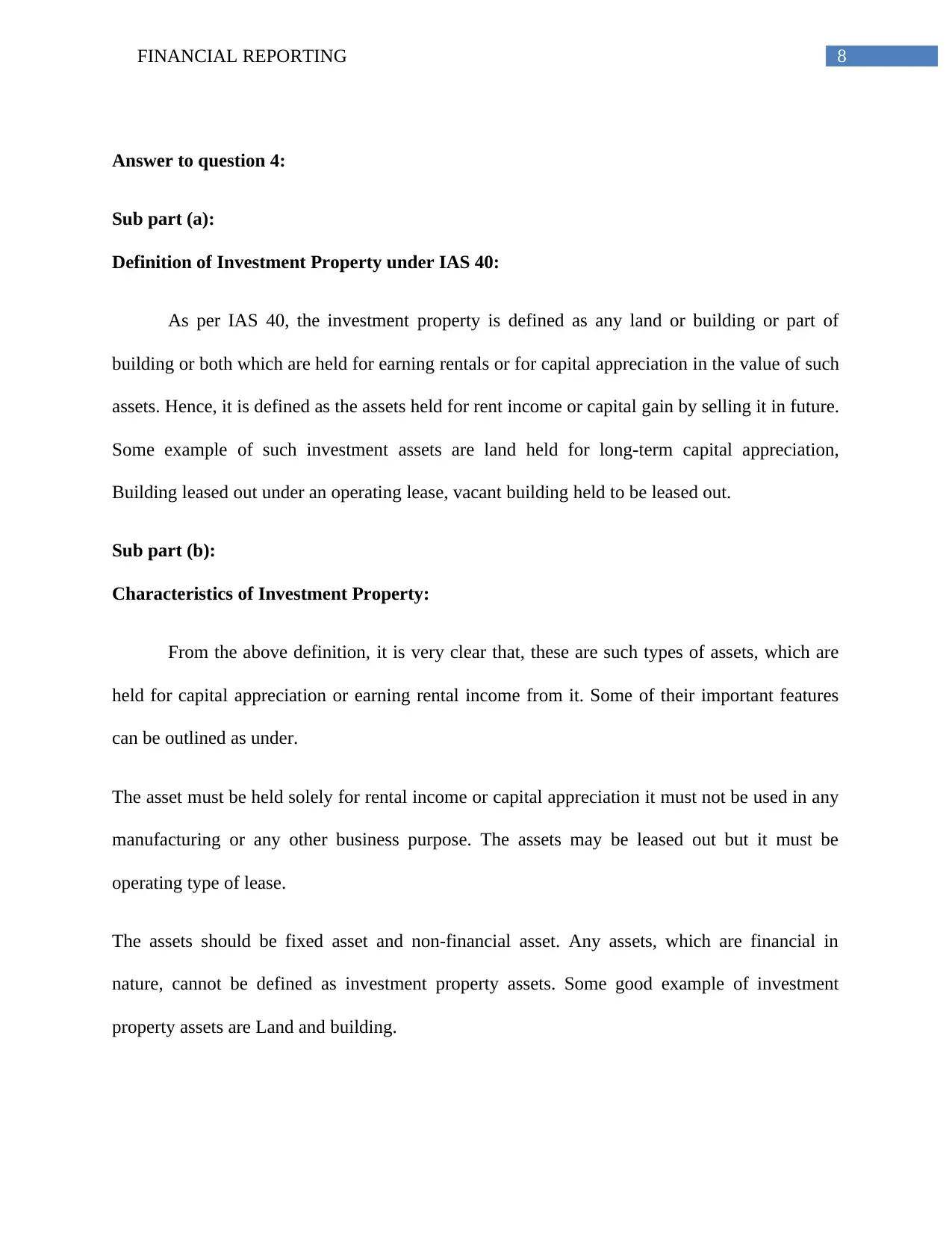
8FINANCIAL REPORTING
Answer to question 4:
Sub part (a):
Definition of Investment Property under IAS 40:
As per IAS 40, the investment property is defined as any land or building or part of
building or both which are held for earning rentals or for capital appreciation in the value of such
assets. Hence, it is defined as the assets held for rent income or capital gain by selling it in future.
Some example of such investment assets are land held for long-term capital appreciation,
Building leased out under an operating lease, vacant building held to be leased out.
Sub part (b):
Characteristics of Investment Property:
From the above definition, it is very clear that, these are such types of assets, which are
held for capital appreciation or earning rental income from it. Some of their important features
can be outlined as under.
The asset must be held solely for rental income or capital appreciation it must not be used in any
manufacturing or any other business purpose. The assets may be leased out but it must be
operating type of lease.
The assets should be fixed asset and non-financial asset. Any assets, which are financial in
nature, cannot be defined as investment property assets. Some good example of investment
property assets are Land and building.
Answer to question 4:
Sub part (a):
Definition of Investment Property under IAS 40:
As per IAS 40, the investment property is defined as any land or building or part of
building or both which are held for earning rentals or for capital appreciation in the value of such
assets. Hence, it is defined as the assets held for rent income or capital gain by selling it in future.
Some example of such investment assets are land held for long-term capital appreciation,
Building leased out under an operating lease, vacant building held to be leased out.
Sub part (b):
Characteristics of Investment Property:
From the above definition, it is very clear that, these are such types of assets, which are
held for capital appreciation or earning rental income from it. Some of their important features
can be outlined as under.
The asset must be held solely for rental income or capital appreciation it must not be used in any
manufacturing or any other business purpose. The assets may be leased out but it must be
operating type of lease.
The assets should be fixed asset and non-financial asset. Any assets, which are financial in
nature, cannot be defined as investment property assets. Some good example of investment
property assets are Land and building.
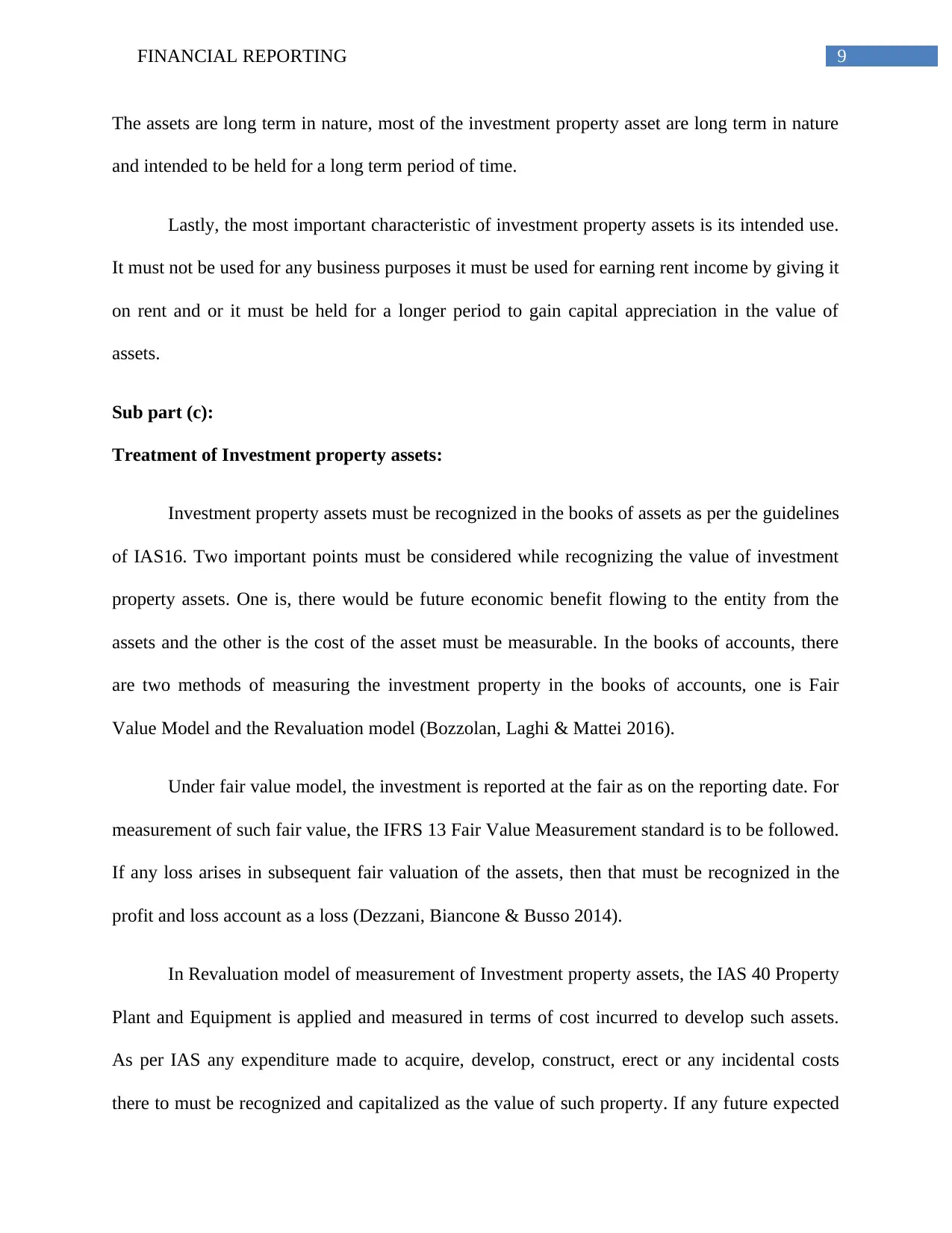
9FINANCIAL REPORTING
The assets are long term in nature, most of the investment property asset are long term in nature
and intended to be held for a long term period of time.
Lastly, the most important characteristic of investment property assets is its intended use.
It must not be used for any business purposes it must be used for earning rent income by giving it
on rent and or it must be held for a longer period to gain capital appreciation in the value of
assets.
Sub part (c):
Treatment of Investment property assets:
Investment property assets must be recognized in the books of assets as per the guidelines
of IAS16. Two important points must be considered while recognizing the value of investment
property assets. One is, there would be future economic benefit flowing to the entity from the
assets and the other is the cost of the asset must be measurable. In the books of accounts, there
are two methods of measuring the investment property in the books of accounts, one is Fair
Value Model and the Revaluation model (Bozzolan, Laghi & Mattei 2016).
Under fair value model, the investment is reported at the fair as on the reporting date. For
measurement of such fair value, the IFRS 13 Fair Value Measurement standard is to be followed.
If any loss arises in subsequent fair valuation of the assets, then that must be recognized in the
profit and loss account as a loss (Dezzani, Biancone & Busso 2014).
In Revaluation model of measurement of Investment property assets, the IAS 40 Property
Plant and Equipment is applied and measured in terms of cost incurred to develop such assets.
As per IAS any expenditure made to acquire, develop, construct, erect or any incidental costs
there to must be recognized and capitalized as the value of such property. If any future expected
The assets are long term in nature, most of the investment property asset are long term in nature
and intended to be held for a long term period of time.
Lastly, the most important characteristic of investment property assets is its intended use.
It must not be used for any business purposes it must be used for earning rent income by giving it
on rent and or it must be held for a longer period to gain capital appreciation in the value of
assets.
Sub part (c):
Treatment of Investment property assets:
Investment property assets must be recognized in the books of assets as per the guidelines
of IAS16. Two important points must be considered while recognizing the value of investment
property assets. One is, there would be future economic benefit flowing to the entity from the
assets and the other is the cost of the asset must be measurable. In the books of accounts, there
are two methods of measuring the investment property in the books of accounts, one is Fair
Value Model and the Revaluation model (Bozzolan, Laghi & Mattei 2016).
Under fair value model, the investment is reported at the fair as on the reporting date. For
measurement of such fair value, the IFRS 13 Fair Value Measurement standard is to be followed.
If any loss arises in subsequent fair valuation of the assets, then that must be recognized in the
profit and loss account as a loss (Dezzani, Biancone & Busso 2014).
In Revaluation model of measurement of Investment property assets, the IAS 40 Property
Plant and Equipment is applied and measured in terms of cost incurred to develop such assets.
As per IAS any expenditure made to acquire, develop, construct, erect or any incidental costs
there to must be recognized and capitalized as the value of such property. If any future expected
⊘ This is a preview!⊘
Do you want full access?
Subscribe today to unlock all pages.

Trusted by 1+ million students worldwide
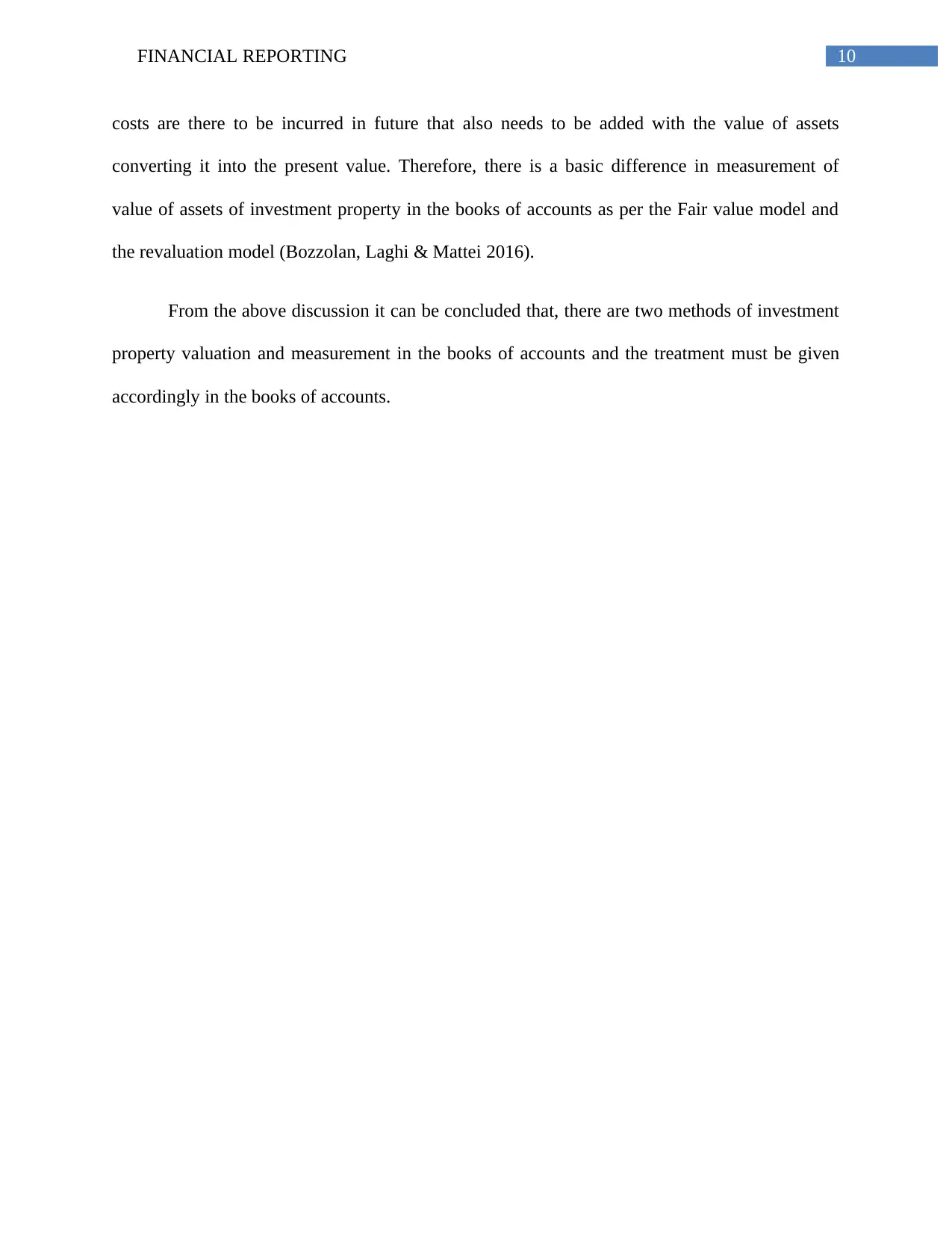
10FINANCIAL REPORTING
costs are there to be incurred in future that also needs to be added with the value of assets
converting it into the present value. Therefore, there is a basic difference in measurement of
value of assets of investment property in the books of accounts as per the Fair value model and
the revaluation model (Bozzolan, Laghi & Mattei 2016).
From the above discussion it can be concluded that, there are two methods of investment
property valuation and measurement in the books of accounts and the treatment must be given
accordingly in the books of accounts.
costs are there to be incurred in future that also needs to be added with the value of assets
converting it into the present value. Therefore, there is a basic difference in measurement of
value of assets of investment property in the books of accounts as per the Fair value model and
the revaluation model (Bozzolan, Laghi & Mattei 2016).
From the above discussion it can be concluded that, there are two methods of investment
property valuation and measurement in the books of accounts and the treatment must be given
accordingly in the books of accounts.
Paraphrase This Document
Need a fresh take? Get an instant paraphrase of this document with our AI Paraphraser

11FINANCIAL REPORTING
References and bibliography:
Alghamdi, F., Mine, B., Morais, R., Scillia, P., & Lubicz, B. (2016). Stent-assisted coiling of
intracranial aneurysms located on small vessels: midterm results with the LVIS Junior
stent in 40 patients with 43 aneurysms. Neuroradiology, 58(7), 665-671.
Bozzolan, S., Laghi, E., & Mattei, M. (2016). Amendments to the IAS 41 and IAS 16-
implications for accounting of bearer plants. Agricultural Economics, 62(4), 160-166.
Capkun, V., Collins, D., & Jeanjean, T. (2016). The effect of IAS/IFRS adoption on earnings
management (smoothing): A closer look at competing explanations. Journal of
Accounting and Public Policy, 35(4), 352-394.
Daske, H., Hail, L., Leuz, C., & Verdi, R. (2013). Adopting a label: Heterogeneity in the
economic consequences around IAS/IFRS adoptions. Journal of Accounting
Research, 51(3), 495-547.
Donti, A., Spinardi, L., Brighenti, M., Faccioli, L., Leoni, C., Fabi, M., ... & Bonvicini, M.
(2015). Frequency of intracranial aneurysms determined by magnetic resonance
angiography in children (mean age 16) having operative or endovascular treatment of
coarctation of the aorta (mean age 3). The American journal of cardiology, 116(4), 630-
633.
Jana, H., & Jitka, Z. (2014). Comparison of Approaches to Financial Reporting of Non-current
Assets According to the IFRS for SMEs and IAS/IFRS. Procedia Engineering, 69, 696-
703.
References and bibliography:
Alghamdi, F., Mine, B., Morais, R., Scillia, P., & Lubicz, B. (2016). Stent-assisted coiling of
intracranial aneurysms located on small vessels: midterm results with the LVIS Junior
stent in 40 patients with 43 aneurysms. Neuroradiology, 58(7), 665-671.
Bozzolan, S., Laghi, E., & Mattei, M. (2016). Amendments to the IAS 41 and IAS 16-
implications for accounting of bearer plants. Agricultural Economics, 62(4), 160-166.
Capkun, V., Collins, D., & Jeanjean, T. (2016). The effect of IAS/IFRS adoption on earnings
management (smoothing): A closer look at competing explanations. Journal of
Accounting and Public Policy, 35(4), 352-394.
Daske, H., Hail, L., Leuz, C., & Verdi, R. (2013). Adopting a label: Heterogeneity in the
economic consequences around IAS/IFRS adoptions. Journal of Accounting
Research, 51(3), 495-547.
Donti, A., Spinardi, L., Brighenti, M., Faccioli, L., Leoni, C., Fabi, M., ... & Bonvicini, M.
(2015). Frequency of intracranial aneurysms determined by magnetic resonance
angiography in children (mean age 16) having operative or endovascular treatment of
coarctation of the aorta (mean age 3). The American journal of cardiology, 116(4), 630-
633.
Jana, H., & Jitka, Z. (2014). Comparison of Approaches to Financial Reporting of Non-current
Assets According to the IFRS for SMEs and IAS/IFRS. Procedia Engineering, 69, 696-
703.

12FINANCIAL REPORTING
Lapointe-Antunes, P., & Moore, J. (2013). The implementation of IAS 16 and IAS 41 at Andrew
Peller Limited. Accounting Education, 22(3), 268-281.
Siyanbola, A. A., Musa, U. M., & Wula, T. J. (2014). An assessment of compliance with
disclosure requirements of IAS 16 by listed agricultural firms in nigeria. International
Journal of Economics, Business and Finance, 2(3), 1-16.
Taplin, R., Yuan, W., & Brown, A. (2014). The use of fair value and historical cost accounting
for investment properties in China. Australasian Accounting, Business and Finance
Journal, 8(1), 101-113.
Tsalavoutas, I., André, P., & Dionysiou, D. (2014). Worldwide application of IFRS 3, IAS 38
and IAS 36, related disclosures, and determinants of non-compliance. ACCA research
report, 134.
Dezzani, F., Biancone, P., & Busso, D. (2014). Ias/Ifrs (pp. 1-2855). Gruppo Wolters Kluver
Italia srl-IPSOA.
Lapointe-Antunes, P., & Moore, J. (2013). The implementation of IAS 16 and IAS 41 at Andrew
Peller Limited. Accounting Education, 22(3), 268-281.
Siyanbola, A. A., Musa, U. M., & Wula, T. J. (2014). An assessment of compliance with
disclosure requirements of IAS 16 by listed agricultural firms in nigeria. International
Journal of Economics, Business and Finance, 2(3), 1-16.
Taplin, R., Yuan, W., & Brown, A. (2014). The use of fair value and historical cost accounting
for investment properties in China. Australasian Accounting, Business and Finance
Journal, 8(1), 101-113.
Tsalavoutas, I., André, P., & Dionysiou, D. (2014). Worldwide application of IFRS 3, IAS 38
and IAS 36, related disclosures, and determinants of non-compliance. ACCA research
report, 134.
Dezzani, F., Biancone, P., & Busso, D. (2014). Ias/Ifrs (pp. 1-2855). Gruppo Wolters Kluver
Italia srl-IPSOA.
⊘ This is a preview!⊘
Do you want full access?
Subscribe today to unlock all pages.

Trusted by 1+ million students worldwide
1 out of 12
Related Documents
Your All-in-One AI-Powered Toolkit for Academic Success.
+13062052269
info@desklib.com
Available 24*7 on WhatsApp / Email
![[object Object]](/_next/static/media/star-bottom.7253800d.svg)
Unlock your academic potential
Copyright © 2020–2025 A2Z Services. All Rights Reserved. Developed and managed by ZUCOL.




